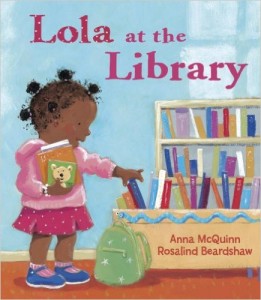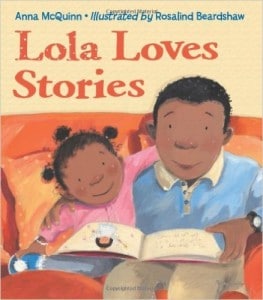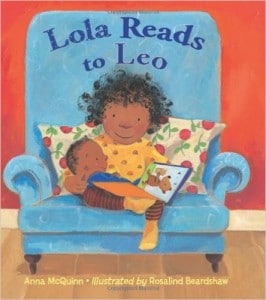 Lola at the Library written by Anna McQuinn and illustrated by Rosalind Beardshaw, has garnered numerous awards*. It deserves each one of them. The story is engaging and features Lola, a sweet African-American girl as the main character. Lola is so excited about her weekly visit to the library, she can’t sleep. She awakens her mother early so they can get ready (with plenty of time to spare!) Lola packs her bag with the books she needs to return, grabs her library card and walks to the library with her mother. Once they arrive, Lola hands the books to the librarian, then she enjoys visiting with the other children. They sing songs, listen to story time, and then choose new books to take home. Lola and her mother enjoy their walk home. At bedtime, they snuggle together and read Lola’s new books.
Lola at the Library written by Anna McQuinn and illustrated by Rosalind Beardshaw, has garnered numerous awards*. It deserves each one of them. The story is engaging and features Lola, a sweet African-American girl as the main character. Lola is so excited about her weekly visit to the library, she can’t sleep. She awakens her mother early so they can get ready (with plenty of time to spare!) Lola packs her bag with the books she needs to return, grabs her library card and walks to the library with her mother. Once they arrive, Lola hands the books to the librarian, then she enjoys visiting with the other children. They sing songs, listen to story time, and then choose new books to take home. Lola and her mother enjoy their walk home. At bedtime, they snuggle together and read Lola’s new books.
Lola at the Library portrays three strong messages. The most obvious: the library is a fun place to visit. Second, Books captivate Lola’s imagination and she loves choosing and reading. Third, mother certainly values reading. After all, she’s spending her time and energy to take Lola to the library and to read her selections to her. A fourth important, although more subtle, message is that mother values reading for herself too. Young readers will intuit this because each time mother and Lola visit the library, mother also selects her own reading material.
We know that parental actions teach our children more persuasively than our words. Mother’s actions live out how she values reading. This reinforces Lola’s interest. Kids who love reading and are exposed to lots of books before they attend school usually fare much better in school. They have broader vocabularies and tend to learn how to read more easily and more quickly. his in turn, reduces stress and encourages kids to like school.
Finally a subtle but pivotal message threads through the story: Lola is repeatedly shown as capable and self-reliant. She gathers her own books. She fills her own backpack. She hands the books to the librarian. When kids are small, they enjoy helping and doing for themselves. Their initial efforts are usually clumsy, time consuming and less-than-perfect. Busy parents may find it hard to “watch and wait” as kids struggle to handle tasks. Patience pays off when kids master tasks. They build a pattern of self-sufficiency that nurtures independence. In the long run, it pays off for the entire family. When kids learn responsibility and independence, this frees parents from having to shoulder it.
 AQ Lens*: Nurturing capability is an exceptionally important practice especially for adoptees who often wrestle with feelings of not being good enough. Building self-reliance results when the family approaches life as a learning conversation. Failure is accepted as the channel for mastery.
AQ Lens*: Nurturing capability is an exceptionally important practice especially for adoptees who often wrestle with feelings of not being good enough. Building self-reliance results when the family approaches life as a learning conversation. Failure is accepted as the channel for mastery.
Another benefit of reading Lola at the Library is the message it telegraphs that books create a shared moment between parent and child as they read together. This creates a model for young readers. If the family book shelf has a wide selection including some on adoption children will see them as a great chance to open adoption conversations!
Beardshaw’s delightful illustrations include a mix of ethnicities in the library, story time and when Lola is out in the community.
AWARDS*
Bank Street College of Education’s The Best Children’s Books of the Year
Book-of-the-Month Cub, Alternate Selection
EarlyChildhoodNews Director’s Choice Award–Judges Selection
National Parenting Award, Honor
Anna McQuinn and illustrated by Rosalind Beardshaw have written two more Lola books. Lola Loves Books features Lola and her daddy while Lola Reads to Leo, tells how Lola reads to her new baby brother. Check them out!



